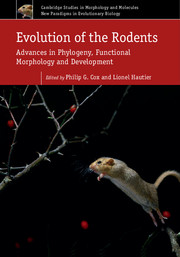Book contents
- Frontmatter
- Contents
- List of contributors
- Foreword
- 1 Rodentia: a model order?
- 2 A synopsis of rodent molecular phylogenetics, systematics and biogeography
- 3 Emerging perspectives on some Paleogene sciurognath rodents in Laurasia: the fossil record and its interpretation
- 4 Phylogeny and evolutionary history of hystricognathous rodents from the Old World during the Tertiary: new insights into the emergence of modern “phiomorph” families
- 5 The history of South American octodontoid rodents and its contribution to evolutionary generalisations
- 6 History, taxonomy and palaeobiology of giant fossil rodents (Hystricognathi, Dinomyidae)
- 7 Advances in integrative taxonomy and evolution of African murid rodents: how morphological trees hide the molecular forest
- 8 Themes and variation in sciurid evolution
- 9 Marmot evolution and global change in the past 10 million years
- 10 Grades and clades among rodents: the promise of geometric morphometrics
- 11 Biogeographic variations in wood mice: testing for the role of morphological variation as a line of least resistance to evolution
- 12 The oral apparatus of rodents: variations on the theme of a gnawing machine
- 13 The muscles of mastication in rodents and the function of the medial pterygoid
- 14 Functional morphology of rodent middle ears
- 15 Variations and anomalies in rodent teeth and their importance for testing computational models of development
- 16 The great variety of dental structures and dynamics in rodents: new insights into their ecological diversity
- 17 Convergent evolution of molar topography in Muroidea (Rodentia, Mammalia): connections between chewing movements and crown morphology
- 18 Developmental mechanisms in the evolution of phenotypic traits in rodent teeth
- 19 Diversity and evolution of femoral variation in Ctenohystrica
- 20 Morphological disparity of the postcranial skeleton in rodents and its implications for palaeobiological inferences: the case of the extinct Theridomyidae (Rodentia, Mammalia)
- Index
- References
20 - Morphological disparity of the postcranial skeleton in rodents and its implications for palaeobiological inferences: the case of the extinct Theridomyidae (Rodentia, Mammalia)
Published online by Cambridge University Press: 05 August 2015
- Frontmatter
- Contents
- List of contributors
- Foreword
- 1 Rodentia: a model order?
- 2 A synopsis of rodent molecular phylogenetics, systematics and biogeography
- 3 Emerging perspectives on some Paleogene sciurognath rodents in Laurasia: the fossil record and its interpretation
- 4 Phylogeny and evolutionary history of hystricognathous rodents from the Old World during the Tertiary: new insights into the emergence of modern “phiomorph” families
- 5 The history of South American octodontoid rodents and its contribution to evolutionary generalisations
- 6 History, taxonomy and palaeobiology of giant fossil rodents (Hystricognathi, Dinomyidae)
- 7 Advances in integrative taxonomy and evolution of African murid rodents: how morphological trees hide the molecular forest
- 8 Themes and variation in sciurid evolution
- 9 Marmot evolution and global change in the past 10 million years
- 10 Grades and clades among rodents: the promise of geometric morphometrics
- 11 Biogeographic variations in wood mice: testing for the role of morphological variation as a line of least resistance to evolution
- 12 The oral apparatus of rodents: variations on the theme of a gnawing machine
- 13 The muscles of mastication in rodents and the function of the medial pterygoid
- 14 Functional morphology of rodent middle ears
- 15 Variations and anomalies in rodent teeth and their importance for testing computational models of development
- 16 The great variety of dental structures and dynamics in rodents: new insights into their ecological diversity
- 17 Convergent evolution of molar topography in Muroidea (Rodentia, Mammalia): connections between chewing movements and crown morphology
- 18 Developmental mechanisms in the evolution of phenotypic traits in rodent teeth
- 19 Diversity and evolution of femoral variation in Ctenohystrica
- 20 Morphological disparity of the postcranial skeleton in rodents and its implications for palaeobiological inferences: the case of the extinct Theridomyidae (Rodentia, Mammalia)
- Index
- References
Summary
Introduction
Rodents constitute roughly half of the current mammalian diversity. This astonishing specific diversity is shown most notably in terms of ecology as they occupy the majority of the ecosystems on the planet, from aquatic environments to desert areas. Current rodent diversity is the result of multiple radiations linked to the invasion of new ecological niches. The diverse rodent groups developed a wide locomotor repertoire, shown first and foremost by a morphological differentiation of the postcranial skeleton. Startlingly, rodents have not traditionally been the animal model of choice for investigating the evolution of the mammalian postcranial anatomy, probably because a great majority of extant species (murids in particular) are often depicted as “terrestrial generalists”. In comparison to the abundant literature on cranial and dental morphology, the rodent postcranial anatomy has received relatively little attention. Meanwhile, inconsistent terminology and imprecision in the definition of habitats, postural behaviors, feeding behaviors, locomotor repertoires (Table 20.1), which are often used interchangeably, have led to confusion.
The fossil record has only occasionally been considered and the extinct species under study often belong to families that still have existing representatives, like sciurids and murids (Vianey-Liaud, 1974; Emry and Thorington, 1982; Szalay, 1985; Price, 1993; Thorington and Darrow, 2000; Bover et al., 2010; Michaux et al., 2012), caviomorphs (Carrano, 1997; Elissamburu and Vizcaino, 2004; Weisbecker and Schmid, 2007; Candela and Picasso, 2008; Araújo et al., 2013), and castoroids (Samuels and Valkenburgh, 2008), although a few concern extinct rodent groups, such as paramyids (Wood, 1962; Szalay, 1985; Rose and Chinnery, 2004). Extinct rodents are mainly documented by isolated bones and finding complete skeletons remains a very rare event. Thus, reconstructing the life history of extinct rodents based on postcranial features seems tentative and extremely challenging. In this context, can palaeontologists contribute to efforts to better understand the evolution of the rodent postcranial anatomy?
- Type
- Chapter
- Information
- Evolution of the RodentsAdvances in Phylogeny, Functional Morphology and Development, pp. 539 - 588Publisher: Cambridge University PressPrint publication year: 2015
References
- 9
- Cited by



